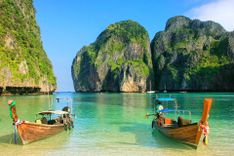Brief history
Chiang Rai is most famous for the things it had and lost. It was founded in 1263 by King Mengrai of Ngon Yang who, having recaptured a prize elephant he’d been chasing around the foot of Doi Tong, took this as an auspicious omen for a new city. Tradition has it that Chiang Rai then prevailed as the capital of the north for thirty years, but historians now believe Mengrai moved his court directly from Ngon Yang to the Chiang Mai area in the 1290s. Thailand’s two holiest images, the Emerald Buddha (now in Bangkok) and the Phra Singh Buddha (now either in Bangkok’s National Museum, Chiang Mai or Nakhon Si Thammarat, depending on which story you believe), also once resided here before moving on – at least replicas of these can be seen at Wat Phra Kaeo and Wat Phra Singh.
Tours and trekking from Chiang Rai
Communities from all the hill tribes have settled around Chiang Rai, and the region offers the full range of terrain for trekking, from reasonably gentle walking trails near the Kok River to tough mountain slopes further north towards the Burmese border; elephant riding is included in most treks. However, this natural suitability has attracted too many tour and trekking agencies, and many of the hill-tribe villages, especially between Chiang Rai and Mae Salong, have become weary of the constant toing and froing; the south side of the river to the west of town is generally a better bet. Sizes of group treks from Chiang Rai tend to be smaller than those from Chiang Mai, often with just two or three people, with a maximum of about seven in a group. Nearly all guesthouses in Chiang Rai can fit you up with a trek – Chat House and Mae Hong Son Guest House are responsible and reliable, typically charging B2500–3500 per person for three days and two nights in a group of between two and six people. One place to avoid is the Union of Hilltribe Villages, just north of Chiang Rai’s airport, where people from various ethnic groups, including “long-neck” women, are brought to live together in an artificial village for the convenience of tourists.
More expensive treks are offered by several nonprofit foundations promoting community-based tourism that are based in and around Chiang Rai. The Hill Area and Community Development Foundation has set up Natural Focus, which offers one- to fifteen-day tours to learn about mountain life, as well as youth, workstay and volunteer skills programmes. Hilltribe Tour, part of the Mirror Art Group, runs tours, one- to three-day treks and longer village homestays, on which you can learn a hill-tribe skill such as weaving or playing an instrument. The development agency PDA at the Hilltribe Museum offers one- or multi-day jungle treks to non-touristy areas, usually including elephant riding and a longtail-boat trip. They also lay on a wide range of guided tours, to their Akha project at Ban Lorcha, Mae Salong and other places of interest. Most of the guesthouses can also arrange sightseeing tours, as well as boat trips, elephant rides and motorbike trekking.
Thinking of travelling to Thailand? Start planning by learning about how to get there.





